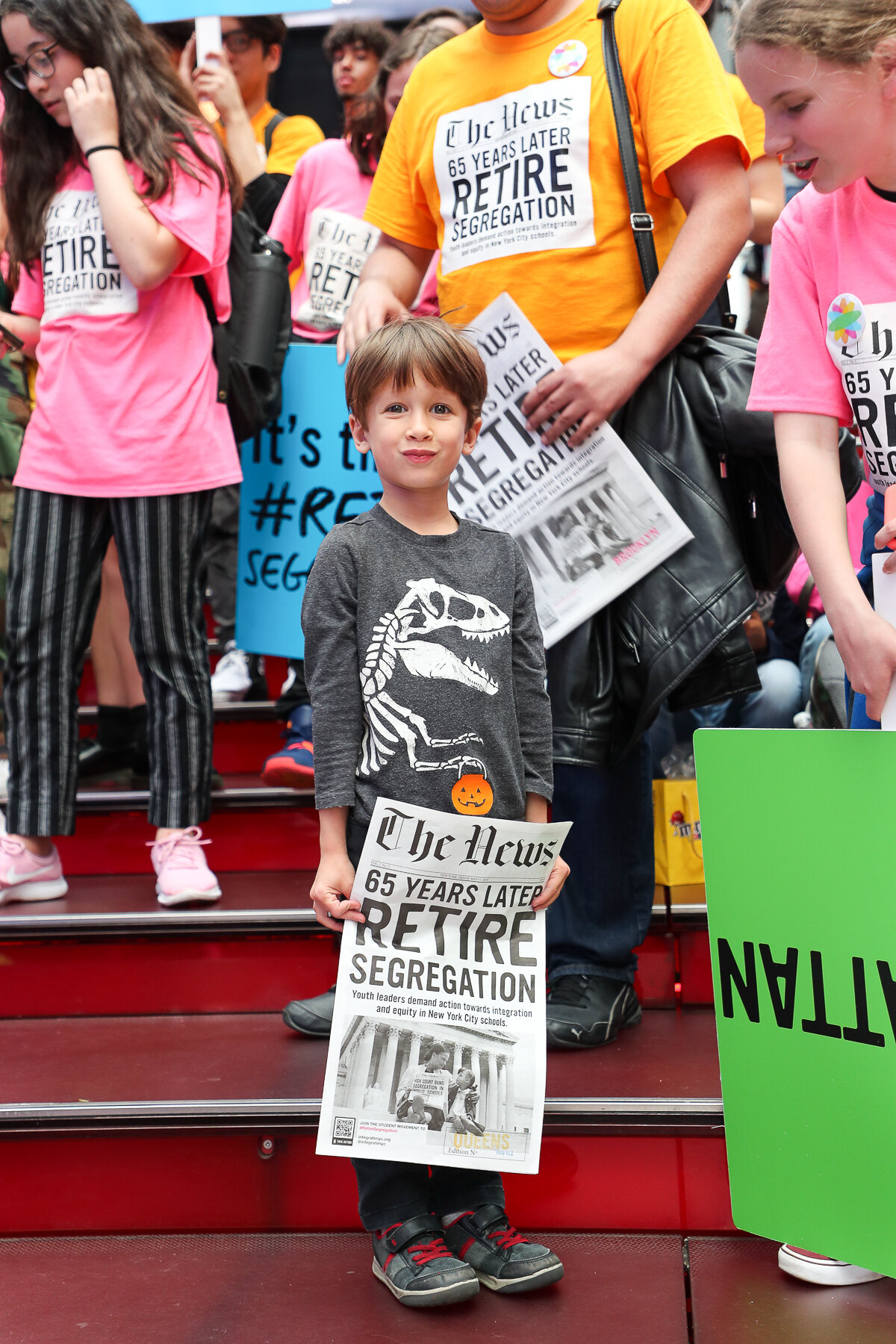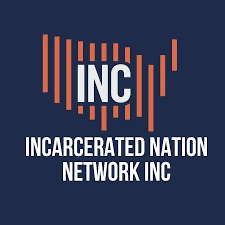
New York City schools remain some of the most segregated in the nation, more than seven decades after the U.S. Supreme Court ruled on Brown vs Board of Education. We made sure it was not ignored.
Spring 2023-2024: “Schools By Us for Us: Give Us Back Our Schools”
Mayoral control has only been implemented in predominantly Black and Latine school districts around the country. Most of them have since abandoned mayoral control. Ever since mayoral control started in NYC in 2002, Mayors have continuously shut out and dismissed the opinions of those most impacted by education inequity — public school students. Adults typically assume that low youth participation on advisory panels and boards is due to a lack of interest, when in fact, reasonable accommodations and accessibility are not considered for meaningful participation.
It’s time to give us back our schools. We want schools for us, by us”
Give student members on community education councils the right to vote, adequate accessibility accommodations, and leadership development support.
Change eligibility requirements for student representatives in school governance to reflect diversity in school experience and academic achievement
End mayoral control and restore community control of NYC Public Schools.
Increase student members on the PEP from two to five.
Reduce mayoral appointees on the PEP from thirteen to five, and replace those seats with elected parent positions.
Spring 2023- “The Youth Justice Fair”
“The Function” was a restorative care event for young people by young people! Intended to be a re-introduction to sharing in person space, this conference featured youth facilitated workshops from allies such as the Restorative Justice Initiative and the Ya-Ya Network. It was a day of music, food, arts, community and connection with the intention to (re)build and amplify student voice in NYC education advocacy.
Spring 2021
#FtheTest
Standardized testing creates stressful and overly competitive learning environments that harm students’ growth as learners and people.
High stakes testing is racist.
Ever since they were created, standardized high stakes tests have largely favored and been beneficial to white students and families who had access to better resources and educational support. While some students were being advantaged by standardized testing, it has caused other students to be actively prevented from getting the opportunities and education they deserve due to their race, financial status, ability, home language, and other identities.
Every year it perpetuates discrimination against already marginalized groups in society. As it has in so many ways, COVID-19 exacerbates these problems and makes the impacts of standardized testing harm students of color at an even larger scale than before.
It has always been inhumane to administer a test that caused harm for disadvantaged students, and this is even more true in the middle of a global pandemic.
In partnership with NYC Opt Out, we call on The Board of Regents to cancel Spring 2021 Regents for all high school students and New York State to halt the Spring 2021 3rd-8th grade state tests.
Signatory organizations
Summer 2020
End Discriminatory Admissions Screens
New York City has the most competitive admission screening process in the country. While the high school admissions process is called “open choice,” the choices students have are dictated by factors like zip code, grades, number of suspensions and arrests, and if a student is able to attend an in-person interview.
This process does not offer an accurate measure of a student’s potential. Instead, it has created a school system that privileges wealth, whiteness, and access. In honor of the 66th anniversary of Brown vs Board of Education, more than 50 organizations and 200 community leaders have already joined us and a coalition of integration advocates in calling for the end to discriminatory admissions screens that perpetuate segregation.
We are calling on Mayor Bill de Blasio, Chancellor Richard Carranza, and the NYC DOE to eliminate all exclusionary public school admissions "screens”.
Summer 2020
Segregation is Killing Us
Contrary to popular belief, COVID-19 is no great equalizer. In New York City, the damaging effects of the virus mirrors the destruction left by generations of segregated communities and schools.
In response to the deep impacts of COVID-19 on our community, we developed the Admissions Impact Score with the help of Territorial Empathy. This policy tool proposes a data-driven method of prioritizing youth in the hardest hit communities. Our goal is to end cyclical racism, which is deeply embedded in the NYC admissions system.
The Admissions Impact Score accounts for key variables:
Neighborhood-level COVID-19 deaths
Lack of insurance
Linguistic isolation
Poverty
Multigenerational housing
Lack of computer access for online learning
In addition, individual student circumstances are taken into consideration, so factors like being a multilingual learner or in temporary housing. These come together to determine a student’s application priority.
The report, Segregation is Killing Us, examines the data that links COVID-19, Redlining, and school segregation. The report also outlines our solution.
Spring 2019
Retire Segregation
On May 17, 2019, the 65th anniversary of Brown v. Board of Education, we demand we #RetireSegregation.
Ahead of the 65th anniversary of Brown v. Board of Education, we compiled our policies and 5R framework into an eye-catching, newspaper-style zine titled The News. It was inspired by a photograph taken on the eve of the U.S. Supreme Court ruling, The News includes games, photographs, student testimonials, quotes, and more. Our goal was to create a document as informative as it is engaging and symbolic.
On May 17, 2019 it came down to five boroughs, five teams, and one goal: to flood NYC with a total of 25,000 copies of The News.
Students from all boroughs helped distribute the paper in trains, streets, residential buildings, you name it. That day, it would have been impossible not to see someone with a copy on your commute home.
Once we had distributed enough copies, we came together at Times Square to throw a retirement party for segregation. After all, 65 years sounds like retirement age. That evening, as young people from across the five boroughs enjoyed cupcakes, loud music, and spirited chants, Times Square was more vibrant than usual.
People from all over the world came to the commercial mecca of NYC to glare at the big screens but left with a fresh perspective on the fight for educational equity.

























































































Spring 2018
Still Not Equal
Most history textbooks will refer to 1954 as the year that school segregation was ended when Brown v Board of Education passed the verdict that segregated schools were inherently unequal.
And yet, it keeps on keeping on. Across the U.S., schools are more segregated than they were 40 years ago.
By May 17, 2019, the 65th anniversary of Brown v. Board of Education, we the students demand:
Relationships
The city release money for schools to design curriculum for an ethnic studies electives in all high schools and pay teachers to do that work.
Race and Enrollment
That the DOE builds on IntegrateNYC’s algorithmic prototype and Teens Take Charge’s 3-Point Enrollment Equity Proposal to release a comprehensive plan that will racially, socioeconomically, and academically integrate public high schools. This plan must be created by a working group with meaningful student representation, alongside community leaders, educators, parents, and experts.
Resources
The DOE releases the first equity report, as outlined in the student Constitution for Real Integration, documenting resources available to students across the city.
The state releases a plan for providing $1.6 billion owed to public schools from the 2003 lawsuit Campaign for Fiscal Equity v. State of New York.
Representation
The DOE names a group of educators, policymakers, and advocates like NYC Men Teach, and students to design a blueprint for a teaching fellowship that provides scholarships for NYC students to become educators who serve NYC public schools.
Restorative Justice
The DOE invites Center for Popular Democracy, Urban Youth Collaborative, Teachers Unite, and the Dignity in Schools Campaign to join the citywide and district level desegregation planning efforts so that their amazing work on restorative justice is included in desegregation planning.
Fall 2017–2018
D15 Diversity Plans
District 15’s schools are among the most socio-economically and racially segregated schools in New York City.
The following text was adapted from the D15 Diversity Plan Final Report
In June 2017, the New York City Department of Education (DOE) shared Equity and Excellence for All: Diversity in New York City Public Schools, a citywide plan that stated the DOE’s commitment to making its schools more diverse. The plan set forth a citywide vision, but also recognized that, in a city as diverse as New York, it can be difficult to create a uniform policy that works well for each community.
Throughout this process, local engagement provided an opportunity to overcome the challenge of adapting a citywide policy to meet the unique needs of each community.
So in the fall of 2017, the DOE initiated a community planning and engagement process, The District 15 (D15) Diversity Plan, aimed at creating diverse, meaningfully integrated middle schools in a way that would meet the needs of the district.
The D15 Diversity Plan followed years of previous advocacy work led by local parents, school leaders, and elected officials. The Plan’s community-based process sought to build off these earlier efforts, to engage the larger D15 community in conversations on race, class, diversity, and integration, and to use community engagement to develop solutions reflective of the diverse needs of D15’s school community.

Through the guidance and leadership of a Working Group—comprised of school community members from across D15 including, IntegrateNYC students, parents, teachers, principals, administrators, community advocates and members of local community-based organizations—the D15 Diversity Plan evolved through four large public events, more than 80 stakeholder meetings including Spanish- and Mandarin- language meetings, a community-based survey and a website all in an effort to understand key concerns, gather feedback and develop recommendations.
D15 MS Students
D15 Suspensions
The Working Group’s recommendations fell within two major themes: Integration and Inclusion.
Integration recommendations address the mechanisms necessary to create integrated school communities, such as school screens, admissions priorities, access to information, transit, and the need for transparency, coordination and ongoing monitoring.
Equally as important are the Inclusion recommendations which reflect the need to create and provide support for welcoming and inclusive school environments for all students by addressing issues related to restorative practices, resource inequity, students with special needs, and physical access.
In the fall of 2018, Mayor Bill de Blasio and Chancellor Carranza approved the D15 Diversity Plan and launched a $2 million school diversity grant program for other school districts and communities across the City to develop their own community-driven diversity plans.
“We believe that our schools can reflect our whole city and we are proud to support and invest in the future of New Yorkers for generations to come. This isn’t going to be one size fits all. This is a ripe moment and this community built a powerful grassroots plan. Now, we have to execute and deliver on it to show parents across the city this approach can work,” said Mayor de Blasio.















































